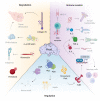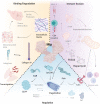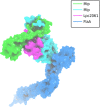Protein sociology of ProA, Mip and other secreted virulence factors at the Legionella pneumophila surface
- PMID: 36936764
- PMCID: PMC10017501
- DOI: 10.3389/fcimb.2023.1140688
Protein sociology of ProA, Mip and other secreted virulence factors at the Legionella pneumophila surface
Abstract
The pathogenicity of L. pneumophila, the causative agent of Legionnaires' disease, depends on an arsenal of interacting proteins. Here we describe how surface-associated and secreted virulence factors of this pathogen interact with each other or target extra- and intracellular host proteins resulting in host cell manipulation and tissue colonization. Since progress of computational methods like AlphaFold, molecular dynamics simulation, and docking allows to predict, analyze and evaluate experimental proteomic and interactomic data, we describe how the combination of these approaches generated new insights into the multifaceted "protein sociology" of the zinc metalloprotease ProA and the peptidyl-prolyl cis/trans isomerase Mip (macrophage infectivity potentiator). Both virulence factors of L. pneumophila interact with numerous proteins including bacterial flagellin (FlaA) and host collagen, and play important roles in virulence regulation, host tissue degradation and immune evasion. The recent progress in protein-ligand analyses of virulence factors suggests that machine learning will also have a beneficial impact in early stages of drug discovery.
Keywords: Legionella pneumophila; computational biology; interactomics; macrophage infectivity potentiator; secreted effectors; surface-associated proteins; zinc metalloprotease ProA.
Copyright © 2023 Scheithauer, Karagöz, Mayer and Steinert.
Conflict of interest statement
The authors declare that the research was conducted in the absence of any commercial or financial relationships that could be construed as a potential conflict of interest.
Figures






Similar articles
-
Legionella pneumophila PPIase Mip Interacts with the Bacterial Proteins SspB, Lpc2061, and FlaA and Promotes Flagellation.Infect Immun. 2022 Nov 17;90(11):e0027622. doi: 10.1128/iai.00276-22. Epub 2022 Oct 31. Infect Immun. 2022. PMID: 36314784 Free PMC article.
-
Peptidyl-Prolyl-cis/trans-Isomerases Mip and PpiB of Legionella pneumophila Contribute to Surface Translocation, Growth at Suboptimal Temperature, and Infection.Infect Immun. 2018 Dec 19;87(1):e00939-17. doi: 10.1128/IAI.00939-17. Print 2019 Jan. Infect Immun. 2018. PMID: 30323027 Free PMC article.
-
Zinc Metalloprotease ProA from Legionella pneumophila Inhibits the Pro-Inflammatory Host Response by Degradation of Bacterial Flagellin.Biomolecules. 2022 Apr 22;12(5):624. doi: 10.3390/biom12050624. Biomolecules. 2022. PMID: 35625552 Free PMC article.
-
Analysis of virulence factors of Legionella pneumophila.Zentralbl Bakteriol. 1993 Apr;278(2-3):348-58. doi: 10.1016/s0934-8840(11)80851-0. Zentralbl Bakteriol. 1993. PMID: 8347938 Review.
-
Peptidylprolyl cis-trans isomerases of Legionella pneumophila: virulence, moonlighting and novel therapeutic targets.Biochem Soc Trans. 2014 Dec;42(6):1728-33. doi: 10.1042/BST20140202. Biochem Soc Trans. 2014. PMID: 25399597 Review.
Cited by
-
Severe Legionnaires' disease.Ann Intensive Care. 2024 Apr 2;14(1):51. doi: 10.1186/s13613-024-01252-y. Ann Intensive Care. 2024. PMID: 38565811 Free PMC article. Review.
-
Legionella pneumophila type II secretome reveals a polysaccharide deacetylase that impacts intracellular infection, biofilm formation, and resistance to polymyxin- and serum-mediated killing.mBio. 2025 Jul 9;16(7):e0139325. doi: 10.1128/mbio.01393-25. Epub 2025 Jun 20. mBio. 2025. PMID: 40539790 Free PMC article.
-
Legionella pneumophila IrsA, a novel, iron-regulated exoprotein that facilitates growth in low-iron conditions and modulates biofilm formation.Microbiol Spectr. 2025 Jan 7;13(1):e0231324. doi: 10.1128/spectrum.02313-24. Epub 2024 Nov 29. Microbiol Spectr. 2025. PMID: 39612475 Free PMC article.
-
Evaluation of Genetic Diversity and Virulence Potential of Legionella pneumophila Isolated from Water Supply Systems of Residential Buildings in Latvia.Pathogens. 2023 Jun 28;12(7):884. doi: 10.3390/pathogens12070884. Pathogens. 2023. PMID: 37513731 Free PMC article.
-
The Development of Neurological Damage in a Patient With Thrombotic Thrombocytopenic Purpura and Legionnaires' Disease: A Case Report.Cureus. 2023 Jul 21;15(7):e42277. doi: 10.7759/cureus.42277. eCollection 2023 Jul. Cureus. 2023. PMID: 37605684 Free PMC article.
References
Publication types
MeSH terms
Substances
LinkOut - more resources
Full Text Sources
Medical

